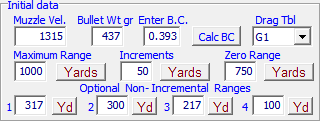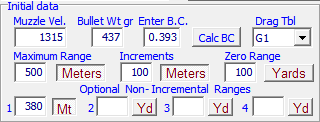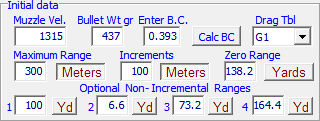
Contents - Index - Previous - Next
Initial Data Entry

Muzzle or Starting Velocity Required Field
Use this field to enter the actual muzzle or starting velocity of the bullet, in feet per second. Valid entries are between the minimum and maximum velocities recorded in the selected Drag Table , usually between 100 f.p.s. and 3,600 f.p.s..
Bullet Weight Required Field
Enter the bullet weight in grains. Valid ranges are between 1 grain and 14,000 grains.
B. C. or Ballistics Coefficient Required Field
Enter whatever decimal number is appropriate to the selected Drag Table.
Calc. BC
If a bullet is not to be chosen from the Bullet Database and the Ballistic coefficient is not known, one may either be calculated or estimated.
Drag Table Required Field
Select a retardation table that is appropriate to the physical configuration of the bullet by clicking on the down arrow in the entry field window and choosing between the G1, GL, G5, G6 or RB Drag Tables.
Maximum Range Required Field
Enter the maximum range of the trajectory in the pre-selected unit of either yards or meters.
Incremental Range
This entry may be any number that, using the same units, can be evenly divided into the maximum range.
If this computer has the capacity to handle the calculations, the maximum range can be as high as 2,000 yards and the increments may be set at one yard, resulting in ballistics and trajectory calculations that return incremental values for 2,000 different points along the trajectory.
This is a Required Field and must contain a value, however, if none is entered the software will enter a value that is equal to the maximum range.
Zero Range
This can be any distance at which the firearm's sights are adjusted to enable the line of sight or aiming point to coincide with the strike of the bullet.
The zero range is usually somewhere within the Maximum Range, but not necessarily so, as some Point-Blank-Range calculations may place the zero range beyond the initial maximum range.
This is a Required Field and must have a value entered, however, if a value is not entered, one will be entered that is equal to the maximum range.

Non Incremental Ranges
The non-incremental ranges can be useful as for instance, when only a 100 yard practice range is available for obtaining a zero range and sight settings are needed for a range that may have targets set at 200, 300, 385 and 500 meters.
Entries into these fields need not be evenly divisible into the maximum range
These entries may have any decimal value that uses the unit of measure of the maximum range.
![]()
The Yards/Meter labels at the right of each field determines the dimension of the data to be entered into the calculations. Clicking the label box will convert the value in the field to either yards or meters as indicated by the label. All values in the final calculations will be converted to the Yards / Meter dimension that has been selected in the Unit Calibration Radio Button Panel.

Non Incremental Range # 1
When Point Blank Range calculations are made, the Point-Blank-Range-Zero range will be entered into the Zero Range field and the original zero range value will be placed in Non Incremental Range #1.
Non Incremental Range #2
When a Point-Blank-Range calculation is performed, the distance at which the trajectory first crosses the line of sight will be entered here for the ballistics and trajectory calculations.
Non Incremental Range # 3
A Point-Blank-Range calculation will enter a value in this field that is equivalent to the range at which the trajectory is at it's maximum height (Maximum Ordinate).
Non Incremental Range # 4
This field will display the Maximum-Point-Blank-Range value.
Copyright 2004 - 2010. TMT Enterprises. All rights reserved